Musicarta Twelve-bar Piano Styles
Two Revision Boogies
Here are some revision boogies to get your fingers moving – and minds working. ‘Minds working’, because you don’t need much for a twelve-bar boogie, but you do need know how it’s organised.
Revision Boogie No.1
Here is the Revision Boogie No.1 video. Watch it straight through a few times to put yourself in the picture. The material is straight out of the Moving Pair stable.
The key is G. In the sequencing software used to process the audio and MIDI, one whole chorus of the boogie looks like this.

We can start picking out information right away. Watch/listen to the first chorus in the audio/video and note the following features.
Chord sequence
Look at the line of the lowest notes. In key G, our three essential twelve bar chords are G, C and D – I, IV and V. The left hand goes both up to V (bar 9) and down to V (bar 12).
The chord sequence therefore is:

The left hand
Looking more closely, you see/hear that the left hand is playing ‘straight quavers’ and marches right up the flattened seventh and down again. Here are a few bars from the MidiPiano Piano Roll pane.
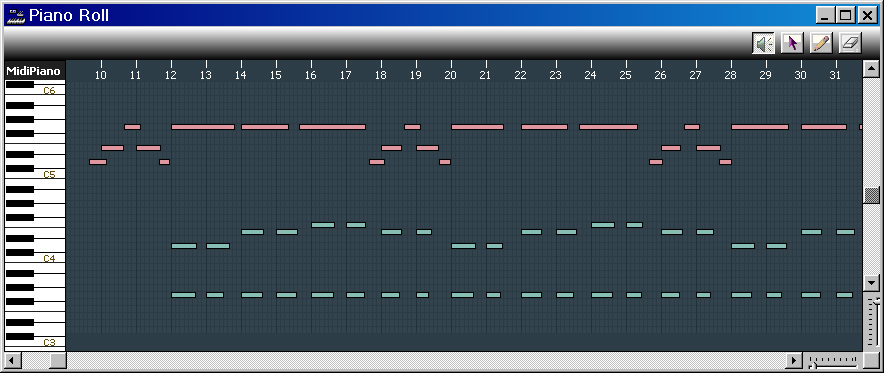
You can quickly work out that the left hand patterns will be these.

Use whatever fingering you like. Your main challenge will be to keep the little finger (LH5) playing every time and not ‘lying down on the job’.
The two-handed pattern
Without syncopation, the main two-handed pattern is this:
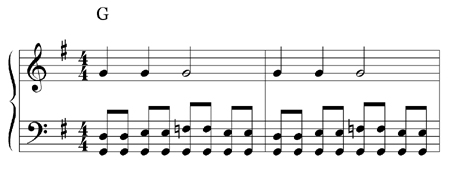
The third right hand note is then pulled forward (anticipated) – to an in-between the left-hand notes slot.
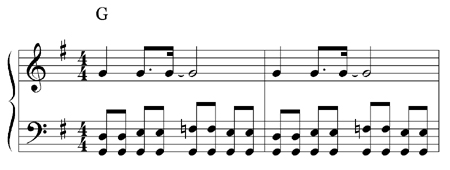
The audio/MIDI demonstrates two bars of each type, repeating, just in G.
The right hand ‘run-ups'
Next, look at the right hand run-ups – the little sequences of right hand notes before the main beat – in the whole-chorus graphic.

You can see there are two types – identify them in the graphic and listen for them in the first chorus of the performance audio.
The run-up notes really belong to the chord they ‘run up’ to – that is how the scale tones are notated in this music example, and why the chord symbols are shifted forward.
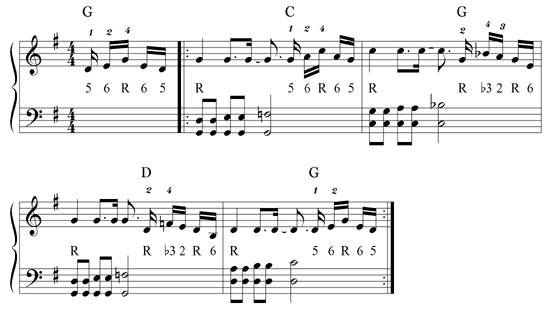
If you can play this practice-speed drill, you can essentially play the whole boogie.
(Even if you’re puzzled at first, it’s worth just staring at those numbers – while you listed to the audio – until it ‘sinks in’. Once you can see-and-hear these notes as scale-tone numbers, you automatically have options for ‘what to play’.)
Second chorus developments
In the second chorus, the left hand little finger starts anticipating the beat. Practice the left hand of the following drill on its own first, then add in the three right hand notes (with syncopation) as demonstrated in the audio/MIDI clips.
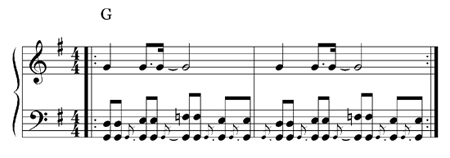
The anticipated notes are shown as grace notes.
When you add the run-up notes, the written music gets even more complicated – you’re much better off with a repeating, slowed-down MIDI segment on MidiPiano and your own good ears to see ‘what goes with what’ (together, left, right analysis).
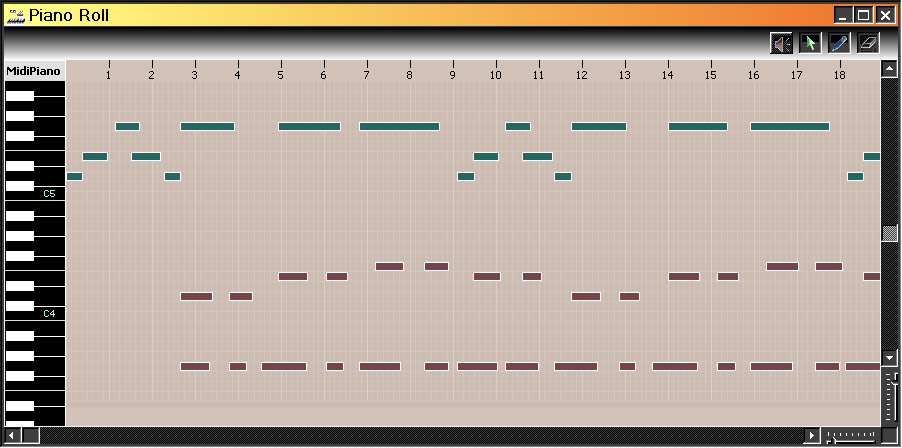
Your on-screen display can be a lot larger and you will easily be able to mentally drop vertical lines from the right hand notes to see which of the left hand fingers (5 or 1) they come with.
Note: The amount of left-hand little finger syncopation you use is entirely optional. (In the third, ‘fade’ chorus of this boogie, the anticipation cuts back and is less regular – listen out for it.) Try to make your anticipation an instinctive choice - it should reflect how you feel about the beat at any point in time.
Other developments include (optional) octaves in the right hand – and notice that the melody note remains G for the C bars 5 and 6.
Here’s an ending

It’s a cliché – but everyone’s supposed to know a cliché, by definition!
Revision Boogie No.2
Watch and/or listen to the Revision Boogie Number Two using the video and audio and load up the MIDI file in MidiPiano or Synthesia for your learning session. The style of the riff should be familiar from Module Eight of the Moving Pair workbook. The MS is on the next page.
Some features
There are just two alternating choruses to this boogie – Strain ‘A’ and Strain ‘B’.
Notice how the chromatic í4 is treated differently right throughout the ‘A’ strain (circled in the MS). Sometimes it occurs as a full quaver on count four, sometimes on “Four and” (the last quaver beat) and sometimes as a crushed notes on count “One” in the next bar. It may be some time before you have small variations like these entirely under control, but in twelve-bar music they are definitely what give each riff its unique character.
Bar 12 consists of a right hand ‘shake’ on notes D, B, D, while the left hand plays octave or single-note Ds. A note-for-note transcription has not been attempted – the performance is slightly different each chorus. Your primary goal will be to get the notes in somewhere, rhythmically, and keeping going. After a while, your own ‘take’ on this traditional bit of boogie finger-work will emerge, and trying to play a micro-transcription will not speed that goal at all!
The MS only shows the right hand of the second strain (the even-numbered choruses). (The left hand remains just the same.) If you count the scale tones, you will easily be able to transpose the pattern into D – or just get it from the MidiPiano playback, slowed down.
Notice that the ‘B’ strain only ventures up as far of the sixth (counting from the root of the presiding chord). That’s what makes the B strain different and makes the simple A/B alternation work.
This second Revision Boogie is indeed a bit of a stamina builder. Boogie-woogie is a very energetic style! Once you can play it, you’ll find a five-minute session very energising. The performance has deliberately been left quite long to give you a sense of the twelve-bar form’s momentum, even when constructed of so little-varied material.
|
OUT NOW! |
THE MUSICARTA BEAT & RHYTHM WORKBOOK At last! An effective approach to keyboard rhythm & syncopation skills. Learn more! |
ONLY $24.95! |
TWELVE-BAR |
The MusicartaA methodical approach to keyboard syncopation for
|
PUBLICATIONS
exciting keyboard
creativity courses
CHORDS 101
WORKBOOK

~HANON~
video course

Musicarta
Patreon
PENTATONICS
WORKBOOK
video course

Creative Keyboard
video course

BEAT AND RHYTHM
WORKBOOK

- Volume 1 -

12-BAR PIANO
STYLES WORKBOOK

MUSICARTA MODES
WORKBOOK

PIANO STYLE

CANON PROJECT
video course

VARIATIONS
video course


- Piano Solo -
video course

- Piano Solo -


YouTube playlists





 THE LOGO
THE LOGO
